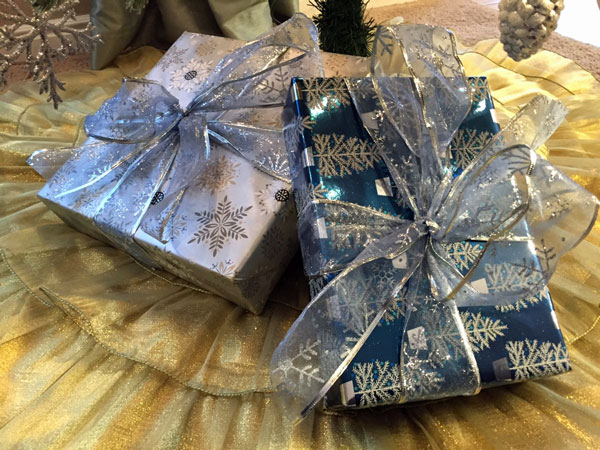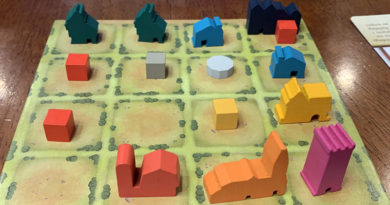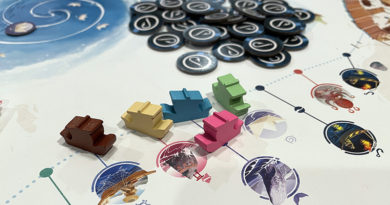Starting My Legacy in My City
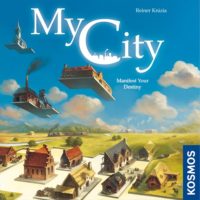
No two cities are alike.
That’s as true in life as it is when playing My City by Thames & Kosmos.
That’s because players in My City will end up with a unique city every game. And there will be many games played!
And not just because My City is a “legacy” game, but because it’s so easy and fun to play you’ll want to play over and over.
At least, that’s how it is with us.
Let’s see if it’s a board game your family will enjoy too.
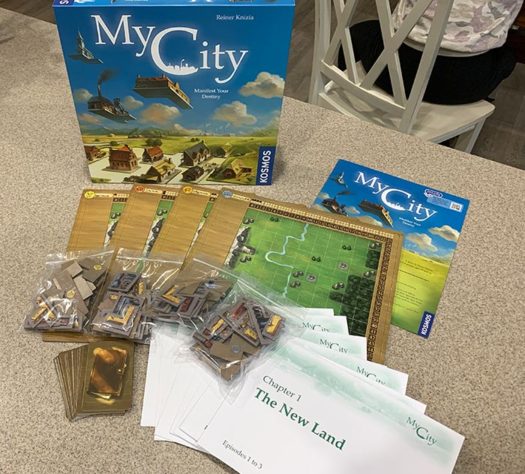
How to play My City
My City is a competitive legacy game where the choices and outcomes from one game carry over to future games. The core game is actually a series of individual games played over 24 “episodes” (games). Every 3 episodes are considered a Chapter. And each chapter has a corresponding envelope filled with new bits, rules, and methods of scoring.
Thus, as players play out the different episodes, there will be plenty of new things to discover and fun challenges to face on the way to building their own unique city.
At the outset, each player gets their own player board that they’ll customize from game to game. And the first thing they do is name their city!
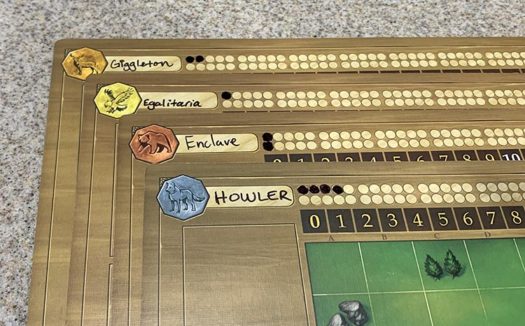
Each player takes the 24 playing pieces with the symbol on the back that matches the symbol on their city board. They’ll place their scoring marker on the number 10 of their scoring track (yes, they can go down from there).
The Construction cards are shuffled and the game is ready to begin!
For the start of a new chapter, the players first open the sealed envelope for the coming episodes in that chapter. Each envelope includes a rule sheet with a few new rules, an overview table that summarizes scoring for the episodes, and stickers that will be used at the end of each episode.
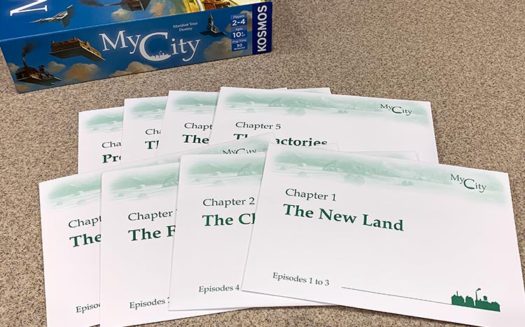
Now on to playing!
A player flips over the top Construction card to reveal a building type (shape and color). Simultaneously, players take their matching tile and place it on a light green space on their board.
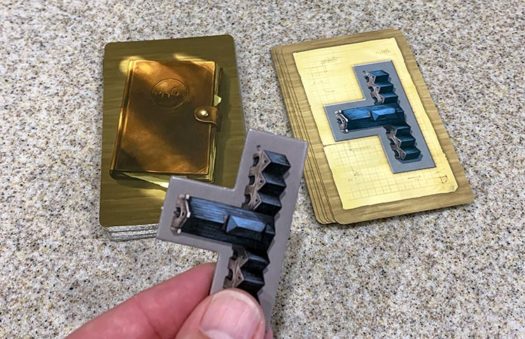
The first building of the game must be placed alongside the river. Thereafter, any building placed must have at least one side bordering another building. Once a building is placed, it may not be moved.
Players may place a building along the river, but may not place a tile so that it straddles the river. Players also may not build in the mountains or the forest. However, players may cover light green spaces that include rocks or trees.
If a player cannot or does not want to place a tile that round, they must place the piece face down next to their board and move their score marker one space backward on their scoring track.
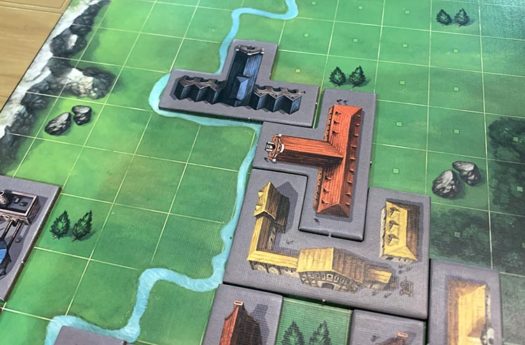
When a player chooses to be done placing buildings that episode, they turn over the remainder of their building tiles (they won’t move backward on their score track).
Players continue to flip over Construction cards and place buildings on their boards until all players choose to be done placing buildings. At that point, the episode ends and players score their cities.
- For each Tree shown on a light green space, the player gets a point.
- For each Rock shown on a light green space, the player loses a point.
- For each empty light green space, the player loses a point.
- (other scoring goals will be added throughout the 24 episodes)
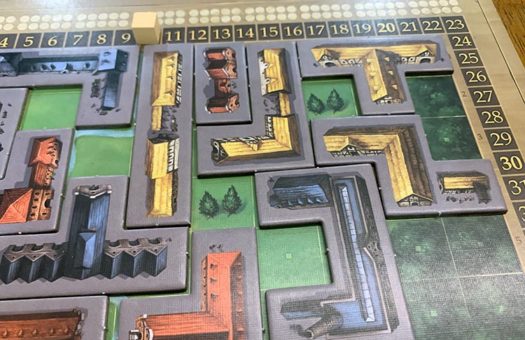
In a 3 or 4-player game, the player/s with the most points colors in 2 progress circles at the top of their board. The player/s with the second-most points colors in 1 progress circle. In a 2-player game, only the player with the highest score colors in progress circles.
Also at the end of an episode, players get to place stickers on their boards. The stickers come in the chapter packet — which also has instructions for how they get distributed.
Players can either call it a day, or move right on to the next episode and/or chapter, clear their boards and play again.
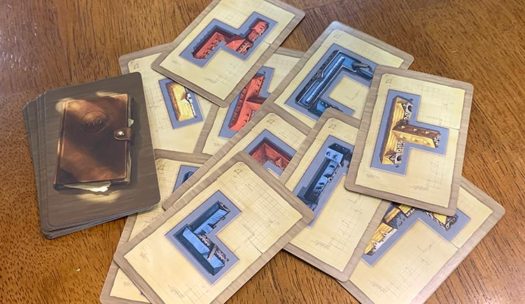
Can the whole family enjoy My City?
My City is a fantastic family board game!
The game mechanics are simple — draw Construction cards, place buildings — but also entail nice choices along the way due to the unique scoring opportunities in each episode. It feels a lot like putting together a puzzle.
Plus, the opportunity to place stickers and customize your city board is a lot of fun.
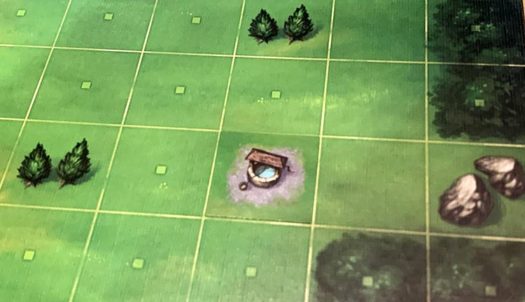
It may not sound like a lot to place a new sticker on your board at the end of an episode, but where you place it will totally have an impact on your future games. Many times you’ll want to build around such stickers in a special way to gain more points. But that means planning ahead. And it can be hard to plan ahead when you don’t know what the next Construction card will be.
So you’ll have to hedge your bets and try to position buildings in such a way to leave you open for the possible buildings yet to come.
It’s a good thing these aren’t stressful choices.
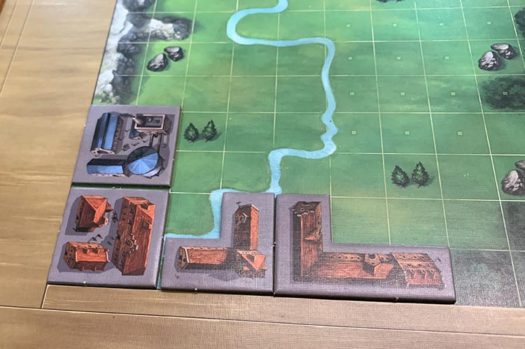
My City is a light-weight game that plays very quickly. So you won’t be agonizing over previous choices forever. You’ll place the next building and move on.
Even though there isn’t direct player interaction (everyone plays on their own board), you will be competing for the highest score each game. Because to the victor goes the most spoils.
That being said, there are also nice consolation prizes to those who finish on the tail end each episode. They can almost feel like “catch up” bonuses. For example, in the first episodes, the players who don’t come in first or second, get to place Tree stickers on their boards. This means they have an opportunity to score more points in future games from those Trees. Whereas, players who come in first have to add a Rocks sticker to their board.
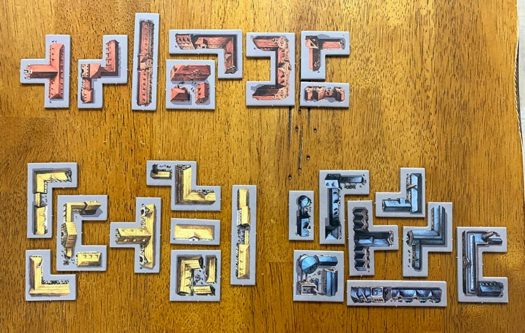
Another reason why games play out so quickly is that all players are playing simultaneously!
There aren’t any player turns. So you’re not waiting around for your next turn. Instead, a Construction card is turned over and everyone places that piece on the board. Then it’s on to the next piece. So everyone is doing something active the whole game. We love that!
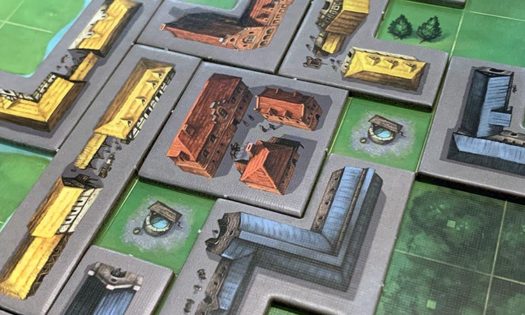
Because of the legacy aspect of the game, the best experience really comes from playing with the same players every time (at least for the first 24 episodes). While it isn’t required, it’s a cool feeling to go through the experience with the same group. That way everyone will be personally invested in how their city turns out and grows from game to game.
While it wouldn’t be hard for someone to pick up and play mid-stream, we can’t imagine them being as invested in what happens to the player board at the end of an episode. Whereas with a player that has been putting stickers on their board for a bunch of games, will have a vision in mind of what they want to do next.
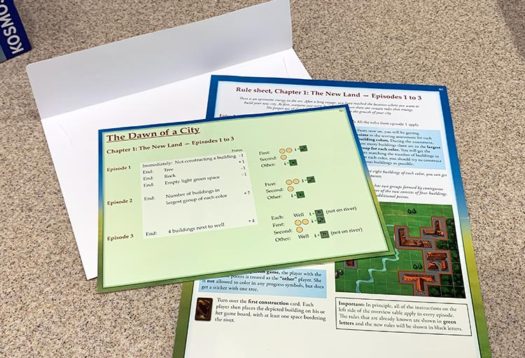
Which brings us to another cool point of My City — you don’t have to play the legacy portion of the game!
The player boards are double-sided so that one side of the board can be played an infinite number of times. The last two pages of the rulebook include instructions on how to play “The Eternal Game” where the rules remain constant and stickers won’t be placed on the board after a game.
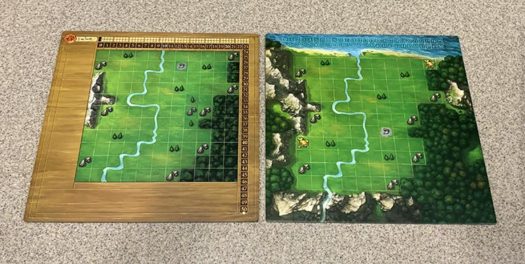
We also like how gradually new rules are added into the game over the course of the chapters. You learn the basics at the outset (like we’ve outlined above), and then you build on them from game to game. Some build on the rules and some provide new ways to score points.
It’s like a meta game of discovery and new challenges along the way. And we love that continued experience over a series of games.
One of the games we’ve enjoyed a lot over the years is a 2-player game called City Square Off. My City reminds us a lot of that.
In City Square Off, a card is flipped and players add the indicated piece to their personal board. The first player that’s unable to add a piece to their board without going off the edge of the board loses. It’s simple, it makes for a fun personal puzzle, and it’s quick.
But even though it’s similar in flipping a card and adding a piece to your personal board, My City offers a very different experience. While it also plays quickly, there’s more to think about while placing your pieces because of the unique scoring options in each game.
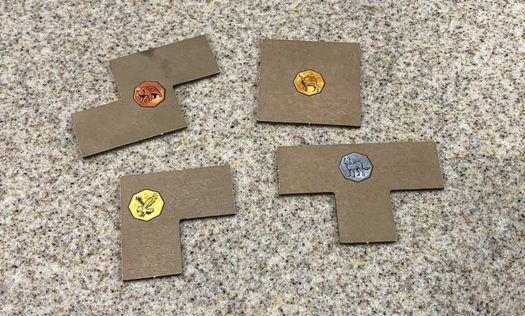
The main frustration we’ve encountered in the game is that the building tiles aren’t double-sided — which means you can’t flip them over to place them. And we’ve had a number of times when we’ve wanted to flip the “s” shaped piece to curve the other way. But we’ve gotten used to that now and plan accordingly.
We’ll happily recommend My City as your next fun family board game.
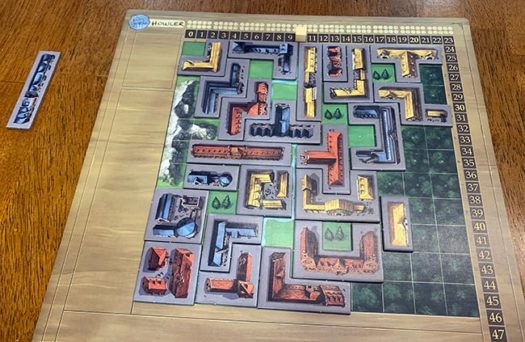
How does My City score on our “Let’s Play Again” game meter?
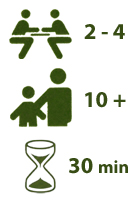 If you haven’t guessed, My City scores extremely well on our “let’s play again” game meter!
If you haven’t guessed, My City scores extremely well on our “let’s play again” game meter!
Not only does the legacy aspect with 24 episodes keep us coming back for more, we also just love the simple fun of it being a tile-laying game with unique scoring challenges.
We haven’t played through all episodes yet and are still looking forward to more cool things ahead. The challenge is in getting the same 4 people together to play it. The 4 we have going at it are dad, mom, Caleb, and Trevor. But Trevor has graduated college and is off on his own. So we have to plan specific nights for him to visit so we can play through another chapter.
Which bring us to our final point. You don’t have to play through a whole chapter at once. You can play a single episode and set the game aside to play another episode on another day. But we have a hard time doing that.
After opening a new chapter packet and seeing what’s ahead, we like to play through 3 games in succession. Plus, after adding stickers at the end of an episode, it’s really hard to pack it up. We’re too interested in playing with the new additions we’d just added on our boards!
We’d like to thank Thames & Kosmos for a review copy of My City.



